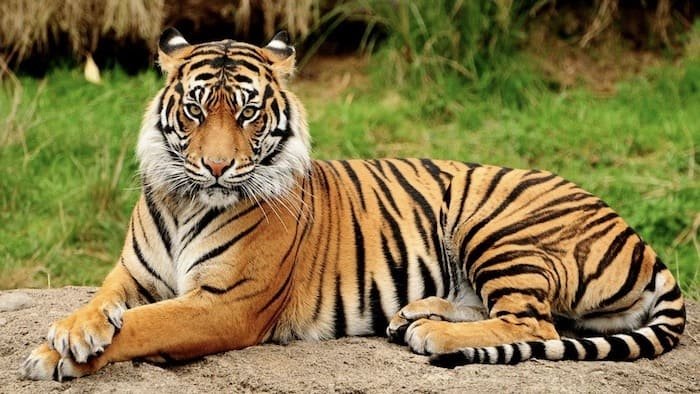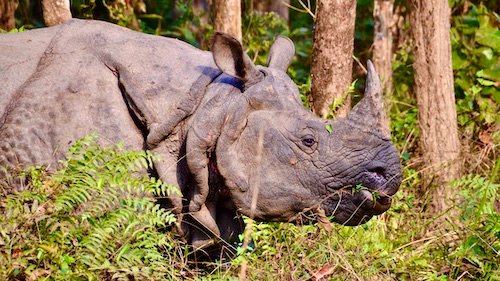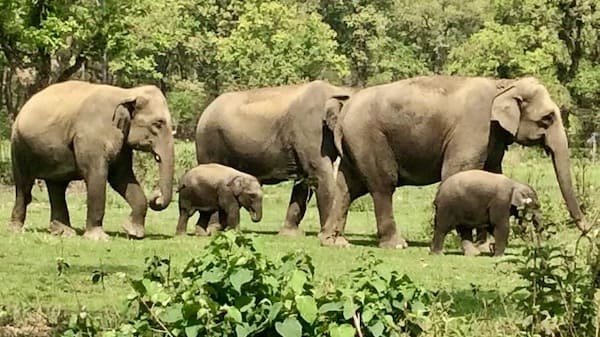Nestled in the lush lowlands of the Terai region, Chitwan is a UNESCO World Heritage site and sanctuary of biodiversity. Chitwan National Park is renowned for its rich and diverse wildlife, particularly the famous big 6 animals that reside there. These majestic creatures represent the most iconic creatures of the park’s thriving ecosystem and are a sight to behold for wildlife enthusiasts.
We will delve into the exploration of the big six animals and their habitants. From Asian elephants to stealthy Bengal tigers and the elusive sloth bear, each of these species plays a crucial role in maintaining the ecological balance of this incredible habitat.
6 Chitwan National Park Animals:
The six most well known Chitwan National Park Animals are called the ‘Big 6’. They are the 1) Bengal Tiger, 2) One-Horned Rhinoceros, 3) Leopard, 4) Sloth Bear, 5) Gaur, 6) Wild Elephant. Below we look at each of the animals and the conservation efforts in Nepal for each of the animals.
1. Bengal Tiger: The Majestic Monarch

Chitwan National Park is home to one of the most iconic and revered big cats of the Indian subcontinent. The Bengal tiger (Panthera tigris tigris)! The Bengal tiger, renowned for its distinctive orange coat adorned with dark stripes, finds a flourishing habitat within the lush grasslands of Chitwan National Park. These apex predators play a critical role in maintaining the ecological balance of the region by controlling prey populations. Thus ensuring a healthy and diverse ecosystem in the region.
One of the best ways to spot the Bengal Tiger is on Nana Jungle Resort’s Big Six Experience! Where you will follow tiger trails in an effort to lay eyes on the iconic creature!
Conservation Efforts:
Nepal has successfully become the first among the 13 nations that committed to doubling their tiger populations by 2022. The latest count reveals a total of 355 big cats within the country.
A detailed report “Status of Tiger and Prey in Nepal” provides a breakdown of the tiger population across various national parks. According to the report’s spatial capture-recapture estimate, the tiger count stands at 41 in Parsa, 128 in Chitwan, 25 in Banke, 125 in Bardiya, and 36 in Shuklaphanta. Particularly noteworthy is the surge in tiger numbers at Chitwan National Park, which recorded 128 tigers in the 2022 census. A significant increase from the 93 tigers reported in the 2018 census.
The park also prioritizes habitat restoration and protection, habitat management, afforestation, and habitat connectivity to ensure tigers have ample space and resources to thrive. Collaborations with international conservation organizations and adherence to global initiatives such as the Global Tiger Recovery Program and the St. Petersburg Declaration further strengthen tiger conservation efforts.
2. One-Horned Rhinoceros: A Prehistoric Relic

The one-horned rhinoceros, also known as the Indian rhinoceros, thrives within the diverse ecosystems of Chitwan National Park. Recognizable by their armor-like skin and a prominent single horn, these herbivores play a crucial role in shaping the landscape and maintaining the ecological balance of the region.
Conservation Efforts:
Conservation efforts to protect the one-horned rhinoceros population in Chitwan National Park encompass a multifaceted approach. Stringent anti-poaching measures, including increased patrols and advanced surveillance technology, have notably reduced poaching incidents and the illegal wildlife trade.
The one-horned rhino population in Nepal has notably increased from 645 in 2015 to 752 as per the latest 2021 survey. Specifically, Chitwan National Park houses the majority with 694 rhinos. Followed by 3 in Parsa National Park, 38 in Bardia National Park, and 17 in Shuklaphanta National Park. This marks a substantial increase of 107 rhinos compared to the 2015 census. Notably, Chitwan National Park boasts the world’s second-largest one-horned rhino population. Estimates consider the population to be no more than 3,500 in the wild.
3. Leopard: The Elusive Feline
Chitwan National Park hosts the most significant leopard population in Nepal, with an estimated count ranging from 70 to 100 individuals inhabiting the park.
Inhabiting areas below 4,400 meters above sea level, these wild cats showcase a distinctive yellow coat adorned with black spots on the head, gradually transforming into captivating black rosettes across the body. What’s remarkable is that these black rosettes are unique to each individual.
Comparatively smaller than tigers, these wild cats belong to the Panthera genus, being one of the five species within it. Their adaptability is notable, allowing them to subsist on a diet of hares, rodents, and sizable birds. When their usual prey, typically weighing between 10 to 15 kilograms, isn’t available. Additionally, they exhibit strength to hoist heavy carcasses into trees, showcasing their remarkable abilities.
Conservation Efforts:
Leopards (Panthera pardus) are an endangered species listed as vulnerable on the IUCN Red List. Despite being highly adaptable, leopards (Panthera pardus) necessitate extensive territories abundant in prey to ensure their survival. However, they face threats such as habitat fragmentation, prey scarcity, poaching, human-wildlife conflict, and trophy hunting.
Alarmingly, a mere 17% of the leopard habitat is situated within protected areas on a global scale. Tiger populations in Nepal have nearly doubled since 2010, owning to dedicated tiger-focused conservation efforts within and around protected areas that are home to tigers. Consequently, the rise in tiger numbers could be a factor driving leopards towards peripheral or less optimal habitats.
Experts warn that without prompt and targeted conservation actions, this rare species is on the verge of extinction. In a report released by the International Union for Conservation of Nature in 2012, Nepal was reported to have a leopard population of 1,000. The same report highlighted a concerning trend of annual leopard population decline.
4. Sloth Bear: A Shaggy Surprise
The sloth bear, scientifically termed Melursus ursinus and commonly referred to as the Indian bear, is a bear species native to the Indian subcontinent. Unfortunately, this unique bear is categorized as vulnerable on the IUCN Red List, primarily due to the loss and degradation of its habitat. The wild population of sloth bears is estimated to be around 20,000 or less.
Sloth bears are generally similar in size to Asian black bears but possess distinct features. They are immediately recognizable by their shaggier coat, whitish claws, and typically leaner build. Notably, their head and mouth have a markedly different structure compared to black bears. It features a longer, narrower skull shape, loose-looking, flappier lips, and a paler muzzle color.
Conservation Efforts
Chitwan National Park is documented to have the densest population of sloth bears in Nepal. According to the Rufford Organization report conducted in the Chitwan National Park mentions that detectability and occupancy of sloth bears are influenced by termite presence and various environmental and human-induced factors. Rapid shifts in habitat variables pose a threat due to the specific dietary and habitat needs of sloth bears. Therefore, habitat changes can lead to a loss of genetic diversity and population decline.
The report emphasizes creating suitable habitats to ensure year-round food access and successful reproduction. Sloth bears can serve as an umbrella species for broader conservation efforts.
Comprehensive assessments within and outside CNP are essential for a complete understanding of sloth bear abundance and conservation significance. These findings provide a critical baseline for future sloth bear conservation strategies in Nepal.
5. Gaur: The Wild Bison
The gaur, scientifically known as Bos gaurus, holds the title of the world’s largest bovine and ranks as the third-largest mammal in both Nepal and Asia. Following the Asian elephant and the greater one-horned rhinoceros, an adult gaur stands impressively tall at 1.7-2.2m at the shoulder. Males typically weigh between 1,000-1,500kg, while females weigh in the range of 700-1,000kg.
Conservation Efforts
The gaur, a formidable animal, holds a ‘Vulnerable’ status on the IUCN Red List and enjoys legal protection in Nepal. Estimates believe their population is ranges from 13,000 to 30,000 individuals.
Recent surveys conducted in Chitwan in 2021 and Parsa in 2022 reported 388 and 164 mammals respectively, shedding light on their current presence in these regions. Notably, population surveys in Chitwan over the years show a steady growth from 188 individuals in 1997 to 388 in 2021.
Recognizing the importance of conserving this species, the Department of National Parks and Wildlife Conservation has devised a comprehensive Gaur Conservation Action Plan for Nepal (2020-2024). This strategic plan aims to maintain their population and safeguard their habitat. The strategy focuses on critical areas like hunting prevention, mitigating disease threats, research and monitoring, habitat protection and management, and fostering collaboration to bolster gaur conservation efforts.
6. Wild Elephant: The Gentle Giants

The most famous of the big 6 animals of Chitwan is the Asian wild elephant! The largest land animal in Asia, can weigh over 6 tonnes, and stands at an impressive height of 3.3 meters! Being herbivores, they consume approximately 150-200 kg of fodder and drink about 100 liters of water in a day.
Conservation Efforts
As of the latest estimates, the number of wild elephants in Nepal has increased to around 400, according to a recent study. There were around 150 elephants in the wild until 2008.
Among them, approximately 15-20 are located in Jhapa district, 17 reside in Koshi Tappu Wildlife Reserve, eight are in Sindhuli, and the majority, around 45-50, can be found in Parsa National Park and Chitwan National Park. On a global scale, estimates show the Asian elephant population between 30,000 and 50,000 individuals.
The Asian elephant holds the designation of an endangered species on the IUCN Red List due to several factors. These factors include habitat degradation and loss of corridor connectivity, shrinkage of habitat outside protected areas, instances of human-wildlife conflict, loss of critical elephant corridors, and the potential risk of diseases like tuberculosis (TB).
Key Takeaways: Big 6 Animals of Chitwan National Park
The Big 6 animals in Chitwan National represent an invaluable treasure of biodiversity, each facing their unique conservation challenges. To ensure the survival and flourishing of these iconic species, concerted conservation efforts are paramount. If you are hoping to catch site of these iconic creatures, Nana Jungle Resort can help! With our Big Six Experience our expert guide takes you throughout the Park to spot these amazing animals! Also we offer an exclusive Overnight Jungle Safari Tour Package that lets you spend the night in the jungle animal watching!
This includes anti-poaching initiatives, habitat preservation, community engagement, and rigorous research to inform effective conservation strategies. Visitors play a crucial role by choosing responsible tourism operators, respecting wildlife and their habitats, and advocating for sustainable tourism practices.
By supporting ethical ecotourism and actively engaging in conservation education, visitors can contribute to the long-term protection and appreciation of these magnificent creatures and their habitats in Chitwan National Park. Together, we can strive for a harmonious coexistence between humans and wildlife, securing a brighter future for these remarkable species.